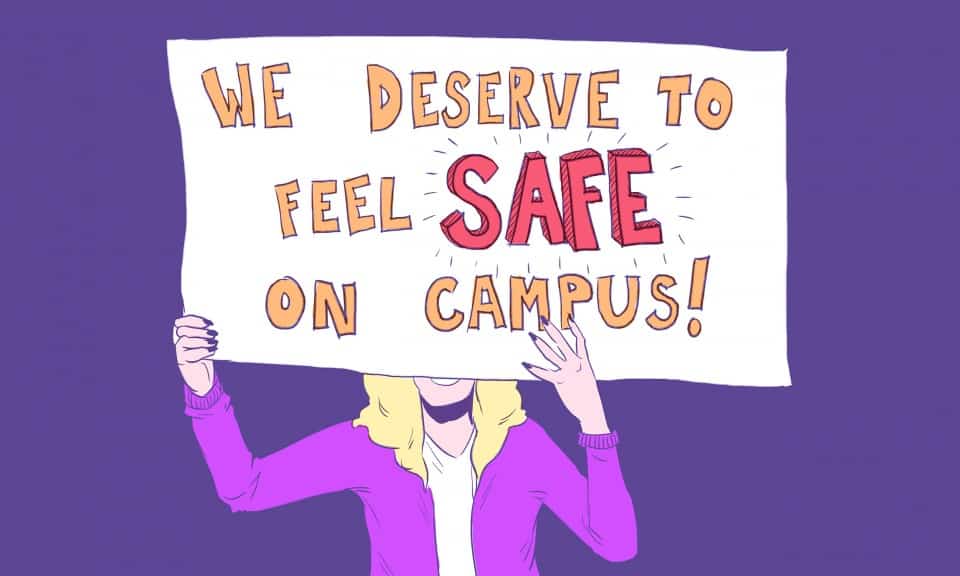[dropcap]At[/dropcap] U of T, the first few weeks of September have always been defined by warm welcomes and happy homecomings. Over the course of a few short days, summer disappears behind us and the excitement of a new semester grows. This is what is expected.
What is not expected during this time — or at any time on a university campus for that matter — is the increased police presence, tersely worded administrative warnings, and sense of uneasy dread that have descended on this institution in the past week.
Shortly after one o’clock in the afternoon on Thursday, September 10, as many of us were waiting in line at the bookstore, dropping in at clubs’ fairs, catching up with, or meeting new friends, a frightening email appeared in our inboxes.
By now, the horrid details that were then unclear have come to light: two weeks ago, an anonymous post in the comment feed of a BlogTO article encouraged readers to go out and execute acts of violence against students at this university.
This threat was the unidentified subject of vice-president and provost Cheryl Regehr’s office’s mass email that afternoon. What this lackluster attempt to promote calm and order on campus neglected to include, however, was that the threat in question was specifically levelled against feminists and students and faculty of the Sociology, and Women and Gender studies departments.
While Toronto Police have been adamant in their conclusion that the post does not represent an immediate risk to students, the university’s reaction to this threat represents a failure to communicate with its community responsibly, a missed opportunity to express solidarity appropriately, and leaves many important questions regarding U of T’s decision making protocol unanswered.
In an age where our lives are saturated with rapid online communication and social media, and information — good or bad — can be shared almost instantly, it can be near impossible to ensure that the facts of a story are communicated effectively. Unsurprisingly, then, it was only a matter of minutes before anyone who received the provost’s email looked up the details online and realized how little the university had actually told us.
In choosing, for whatever reason, to omit certain details of the threat, the university put itself off balance and opened itself up to much of the warranted criticism that has befallen it since. We were going to find out what was going on, so keeping the community partially out of the loop seems suspicious, if not baffling, particularly given the administration’s absent justification for this decision.
Beyond creating problems for itself from a public relations perspective, by choosing not to provide students and staff with all of the information available, the university also ran the significant risk of inciting unnecessary and widespread panic in the community. This is not to downplay the seriousness of any threat, regardless of its credibility, whether it is against one, some, or all of us; but in the decision not to share the specifics, the administration risked provoking a precarious reaction.
Perhaps what is most troubling however, is that by passing up on the opportunity to keep the community fully informed, U of T also shamefully wasted a chance to express some much needed solidarity with feminists, Women and Gender Studies and sociology students and faculty, as well as the community at large. By presenting the threat as an abstract, anomalous occurrence — as opposed to contextualizing it as a symptom of widespread negative treatment of women and feminists — the administration failed to come out ahead for having the done right thing — not only keeping us safe, but acknowledging the reality of misogyny in our society.
Now that the dust has settled and the facts have been laid bare, the university’s subsequent statements of support are not without an air of inauthenticity. The moment to support the feminist community in a dangerous time has passed and everything released since is backtracking. The administration’s initial silence on the gendered nature of this threat — not to mention its lack of information surrounding similar threats in June — signalled a disregard for the sexism that informed the threat to begin with.
It is not with out some incredulity that at this time, and in this place, we feel the need to denounce violence against women, in all forms, in the harshest terms. Yet, the sad truth is, as Teju Cole once noted, “the absurdity of our predicament makes it necessary to spell out obvious things in detail, even… things we already know, or should already know.”


